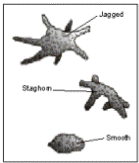Autoimmune Diseases
Kidney stone TYPES
Download the complete cancer prevention and treatment guide
 Kidney Stones in Adults
Kidney Stones in Adults
Cystinuria and hyperoxaluriaare two other rare, inherited metabolic disorders that often cause kidney stones. In cystinuria, toomuch of the amino acid cystine, which does not dissolve in urine, is voided. This can lead to the formation of stones made of cystine. In patients with hyperoxaluria, the body produces too much of the salt oxalate. When there is more oxalate than can be dissolved in the urine, the crystals settle out and form stones.
 Shapes of various stones. Sizes are usuallysmaller than shown here.
Shapes of various stones. Sizes are usuallysmaller than shown here.Hypercalciuria is inherited. It is the cause of stones in more than half of patients. Calcium is absorbed from food in excess and is lost into the urine. This high level of calcium in the urine causes crystals of calciumoxalate or calcium phosphate to form in the kidneys or urinary tract.
Other causes of kidney stones are hyperuricosuria which is a disorder of uric acid metabolism, gout, excess intake of vitamin D,urinary tract infections, and blockage of the urinary tract. Certain diuretics which are commonly called water pills or calcium-based antacids may increase the risk of forming kidney stones by increasing the amount of calcium in the urine.
Calcium oxalate stones may also form in people who have a chronic inflammation of the bowel or who have had an intestinal by pass operation, or ostomy surgery. As mentioned above, struvite stones can form in people who have had a urinary tract infection. People who take the protease inhibitor indinavir, a drug used to treat HIV infection, are at risk of developing kidneystones.
What are the symptoms?
Kidney stones often do not cause any symptoms. Usually, the first symptom of a kidney stone is extreme pain, which occurs when a stone acutely blocks the flow of urine. The pain often begins suddenly when a stone moves in the urinary tract, causing irritation or blockage.Typically, a person feels a sharp, cramping pain in the back and side in the area of the kidney or in the lower abdomen. Sometimes nausea and vomiting occur. Later, pain may spread to the groin.
If the stone is too large to pass easily, pain continues as the muscles in the wall of the tiny ureter try to squeeze the stone along into the bladder. As a stone grows or moves, blood may appear in the urine. As the stone moves down the ureter closer to the bladder, you may feel the need to urinate more often or feel a burning sensation during urination.
If fever and chills accompany any of these symptoms, an infection may be present .In this case, you should contact a doctor immediately.
Contine to How are kidney stones diagnosed? 😏